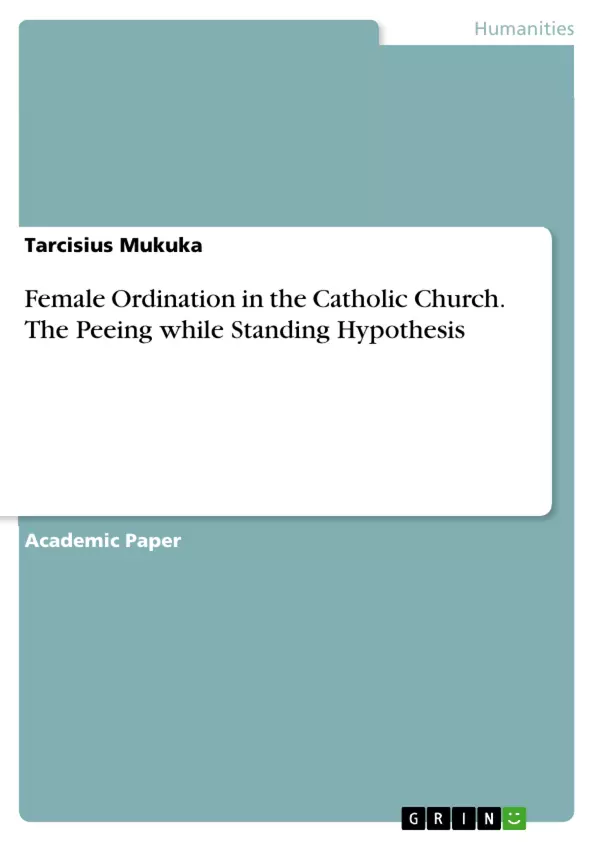This article provides a theoretical and literature framework accompanying a currently ongoing six-month post-doctoral research project, "Female Catholic Ordination to the Diaconate, Priesthood and Episcopate: A Constructivist-Epistemological-Phenomenological Inquiry," a post-doctoral research project submitted to the Kwame Nkrumah University of Kabwe, Zambia and the University of Pretoria in Pretoria, South Africa.
Essentially, the article debunks the argument of the Magisterium of the Catholic Church that "the Church has no authority whatsoever to confer priestly ordination on women and that this judgment is to be definitively held by all the Church’s faithful". The argument goes something like this. The priest presiding at Mass does so in persona Christi [in the person of Christ], therefore the priest must be male because Jesus was male, at least for 30-plus of his life in first century Palestine. The priest stands in for Jesus and therefore has to have a "natural resemblance" to the earthly Jesus, and that resemblance is his maleness. Just why this male resemblance is important is not set out in black and white. Being human or Jesus’ post-resurrection status in which gender or sex are irrelevant, do not cut the ontological mustard.
Inhaltsverzeichnis (Table of Contents)
- Introduction
- A Catholic Priest enters a Women's Public Toilet
- The Toilet-Seat Up or Down Debate
- My Point of Departure
- Constructivism, Epistemology and Phenomenology and a Deficient Female Peeing While Standing or Habet duos testiculos et bene pendentes Hypothesis
- Female Ordination in the Catholic Church: Banging on a Closed Door...
- The Pontifical Biblical Commission and Ordination of Women
- Absurdity of the Female Exclusion Criterion
- Catholic Female Ordination: When Complementarians meet Egalitarians
- The Danube Seven: It is not for lack of trying on the part of women..
- Conclusion
Zielsetzung und Themenschwerpunkte (Objectives and Key Themes)
This article summarizes the Catholic Church's position on female ordination, providing a theoretical and literature-based framework. It complements an ongoing research project examining the historical and theological reasons behind the exclusion of women from holy orders in the Catholic Church. The article examines key arguments for and against female ordination, exploring the historical context, theological debates, and potential consequences of such a change.
- The historical development of the Catholic Church's stance on female ordination
- The theological arguments for and against the ordination of women
- The impact of the ordination of women on the Catholic Church and society
- The role of patriarchy and male-gendered clericalism in shaping the debate on female ordination
- The potential implications of female ordination for the Catholic Church's future
Zusammenfassung der Kapitel (Chapter Summaries)
- Introduction: This chapter sets the stage for the article, introducing the research project and outlining the central question of female ordination in the Catholic Church. It highlights the historical and theological context of the debate.
- A Catholic Priest enters a Women's Public Toilet: This chapter uses a humorous anecdote to illustrate the absurdity of the argument against female ordination based on biological differences. It connects the issue of female ordination to broader societal structures of patriarchy and male dominance.
- The Toilet-Seat Up or Down Debate: This chapter delves into the historical roots of patriarchy, tracing its origins back to Roman law and its impact on societal norms and legal structures. It connects this historical context to the Catholic Church's position on female ordination.
- My Point of Departure: This chapter clarifies the author's personal stance on female ordination, emphasizing his opposition to the Catholic Church's current position and highlighting the need for greater theological and social inclusivity.
- Constructivism, Epistemology and Phenomenology and a Deficient Female Peeing While Standing or Habet duos testiculos et bene pendentes Hypothesis: This chapter introduces the author's theoretical framework for understanding the female ordination debate, drawing on constructivist, epistemological, and phenomenological perspectives. It introduces the central hypothesis of the article, which posits that the exclusion of women from ordination is based on unfounded assumptions about gender roles and biological differences.
- Female Ordination in the Catholic Church: Banging on a Closed Door...: This chapter explores the Catholic Church's history of resistance to female ordination, examining the various arguments and justifications used to maintain the status quo. It highlights the voices of individuals and groups advocating for change.
- The Pontifical Biblical Commission and Ordination of Women: This chapter examines the pronouncements and interpretations of the Pontifical Biblical Commission on the issue of female ordination, analyzing their impact on the ongoing debate.
- Absurdity of the Female Exclusion Criterion: This chapter critiques the arguments against female ordination, highlighting their inconsistencies and lack of theological and historical grounding. It challenges the Catholic Church's reliance on traditional interpretations and calls for a more nuanced understanding of scripture and tradition.
- Catholic Female Ordination: When Complementarians meet Egalitarians: This chapter explores the different perspectives within the Catholic Church regarding female ordination, examining the views of both complementarians and egalitarians. It analyzes the complexities of the debate and the potential for dialogue and reconciliation.
- The Danube Seven: It is not for lack of trying on the part of women..: This chapter focuses on the experiences of women who have been actively advocating for female ordination within the Catholic Church. It highlights their efforts, challenges, and ongoing commitment to achieving equality in the Church.
Schlüsselwörter (Keywords)
Key terms and concepts that define the focus of the article include female ordination, Catholic Church, patriarchy, male-gendered clericalism, theological arguments, historical context, complementarianism, egalitarianism, constructivism, epistemology, phenomenology, and the "Peeing while standing" hypothesis.
- Arbeit zitieren
- Dr Tarcisius Mukuka (Autor:in), 2021, Female Ordination in the Catholic Church. The Peeing while Standing Hypothesis, München, GRIN Verlag, https://www.grin.com/document/990332



